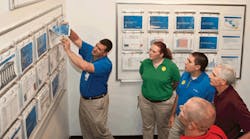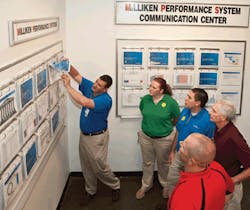Milliken's Keys to Employee Engagement, Increased Workplace Safety and Productivity
More than 20 years ago, hourly production associates at Milliken's Gilliland plant in Laurens, S.C., concretely demonstrated the fact that heightened engagement contributed to a dramatic reduction in the Total Incident Rate (TIR). The two decades that followed witnessed the replication of Gilliland's process of engagement across the company.
This year, a Hay Group survey of Milliken's 7,000 associates worldwide found 80 percent positive engagement levels, as determined by responses to a series of questions related to each associate's commitment, pride in the company and discretionary efforts. This engagement is strongly related to the company's overall performance and has contributed to Milliken's incredible success as a global innovation company with 39 high-performing manufacturing facilities. This reason alone might account for the staggering 154 percent increase in companies visiting the Johnston plant between 2011 and 2012, hoping to replicate both the strategies and tactics behind Milliken's engagement levels.
Subscribe to EHS Today Magazine to receive leading coverage of the EHS industry.
An analysis of the events, processes, and strategies that transpired at Milliken's plants is instructive to those interested in boosting plant-wide engagement to meet real-life challenges, fully illustrating the effectiveness of Milliken's Safety Way system.
A Leap of Faith
Long-tenured Milliken leaders maintain a vivid memory of Feb. 22, 1992. Prepared to hear another marquee speaker typical of the annual meeting they were attending, the nearly 400-member audience instead met a panel of nine, hourly production associates from the company's Gilliland Plant. Gilliland's 1992 safety and engagement results pleasantly surprised Milliken's top leadership. The audience peppered the panel with questions.
Their answers would spark a company-wide cultural transformation focused on improving safety, which resulted in the total company incident rate of 2.0 being reduced by one full point in just 1 year. Further, Milliken has averaged a TIIR of .63 for the past decade. No easy task.
It was a leap of faith. Nine Gilliland associates owned the safety process because key plant leaders had been willing to relinquish an appropriate amount of control.
"The plant manager told us we might make mistakes," says Joe Lyons, a Milliken maintenance specialist for the past 44 years and a member of Gilliland's original associate-led safety committee. "But he told us mistakes are a part of life."
Lyons added: "He always said if we could take care of our home, we could take care of our plant."
Safety ownership and concern allowed Milliken to attain true associate engagement – a catalyst that positively affected all areas of safety and performance. The entire plant population became trusted partners in running a business.
Accountability and Respect
In a highly engaged environment, production teams acquire a pragmatic understanding of continuous improvement methodologies and find solutions to chronic problems. Rather than host traditional meetings where leaders inform associates of key performance metrics, Milliken associates present both safety and performance results so leadership can provide the support needed to drive improvement.
David Inman, the company's Johnston plant manager, adds, "A strong and collaborative culture enables the leadership team to leverage these metrics as directional indicators to help close gaps." Milliken's planning process "works because we allow our associates to participate in goal-setting and provide feedback and solutions for attaining the goals we set," says Inman. Production associates complete both conditions-based and behavioral safety audits. Posted performance metrics reflect plant, departmental and even individual performances.
Perhaps the largest sign of respect a manager can give his or her associates is to relinquish control and trust that they will be accountable. Visitors to Milliken facilities often question the plants' posting of individual performances. Trust and engagement allows for this; the process allows best practices to become standardized and shared.
Peer-to-peer feedback around safety compliance becomes a culturally accepted practice. Associates routinely write One Point Lessons and participate in risk-reduction activities and safety subcommittees. But this doesn't happen by chance. Engagement is embedded into Milliken's safety process, which provides the foundation to build an environment where associates are more effective and efficient.
The group of nine who presented made it clear that the process had to be positive. Recognition and respect would ensure full participation. Great leaders can set the stage for heightened engagement. "As leaders, we must model the behaviors we would like our associates to demonstrate," says Inman.
Take a Closer Look
"Johnston's success stems from its people. From the leadership to the production floor, we are a team," says Inman. The Johnston team completed 2011 with a TIR of .42 and has averaged a .42 TIR over the past 5 years.
"Engaged associates leading residual risk activities have made the difference," adds Inman. Milliken drives safety incidents down towards its goal of zero using a 100-percent, engaged, associate-led safety model comprised of safety subcommittees, a steering committee governed by associates and leadership support. Inman cites five key tactical strategies that support the plant's success:
- Organizational structure – The safety process is driven by the 16 associates on the Safety Steering Committee, which governs eight subcommittees: Rules & Procedures, Environmental, Fire & Emergency, Process Hazards, Ergonomics, PPE, Material Handling and On/Off-the-Job Safety Awareness. The Committee drives initiatives through the subcommittees and ensures proper communication is maintained.
- Cascading goals – Corporate-, state-, and federally mandated guidelines are communicated through weekly safety meetings. Initiatives are assigned to subcommittees and goals are consistently reviewed and updated.
- Audits – Each subcommittee performs weekly, discipline-specific audits to ensure compliance and that continuous improvement activities are supported and sustained. Peer-to-peer behavior audits also are performed weekly to recognize risk. From the day an associate begins working, he or she is taught how to give and receive both positive and constructive feedback.
- Associate engagement – Throughout Milliken, the safety process is 100 percent associate-led. Each associate understands his or her part in making the company a safer place to work. Through subcommittees, each associate is involved with residual risk reduction projects that reduced risk by at least 50 percent in key activities. Opportunity for Improvement (OFI) suggestions are submitted weekly by associates and are reviewed during the Safety Steering Committee meeting and assigned an owner. Feedback is given on every suggestion, no matter how small. Ideas gathered from associates have proven to be very powerful.
- Celebration and awareness – Leadership recognizes workers' hard work and dedication through celebratory events held throughout the year. Awareness activities, such as an annual spirit day where cheerleaders provide safety cheers as associates enter the plant, are just one of the ways safety is boosted at Milliken.
Robert Allen is a 32-year Milliken veteran, providing leadership as a plant manager at five sites. Carly Tebbetts has a 16-year tenure with Milliken and served as a plant manager. Visit http://www.performancesolutionsbymilliken.com to learn more.

